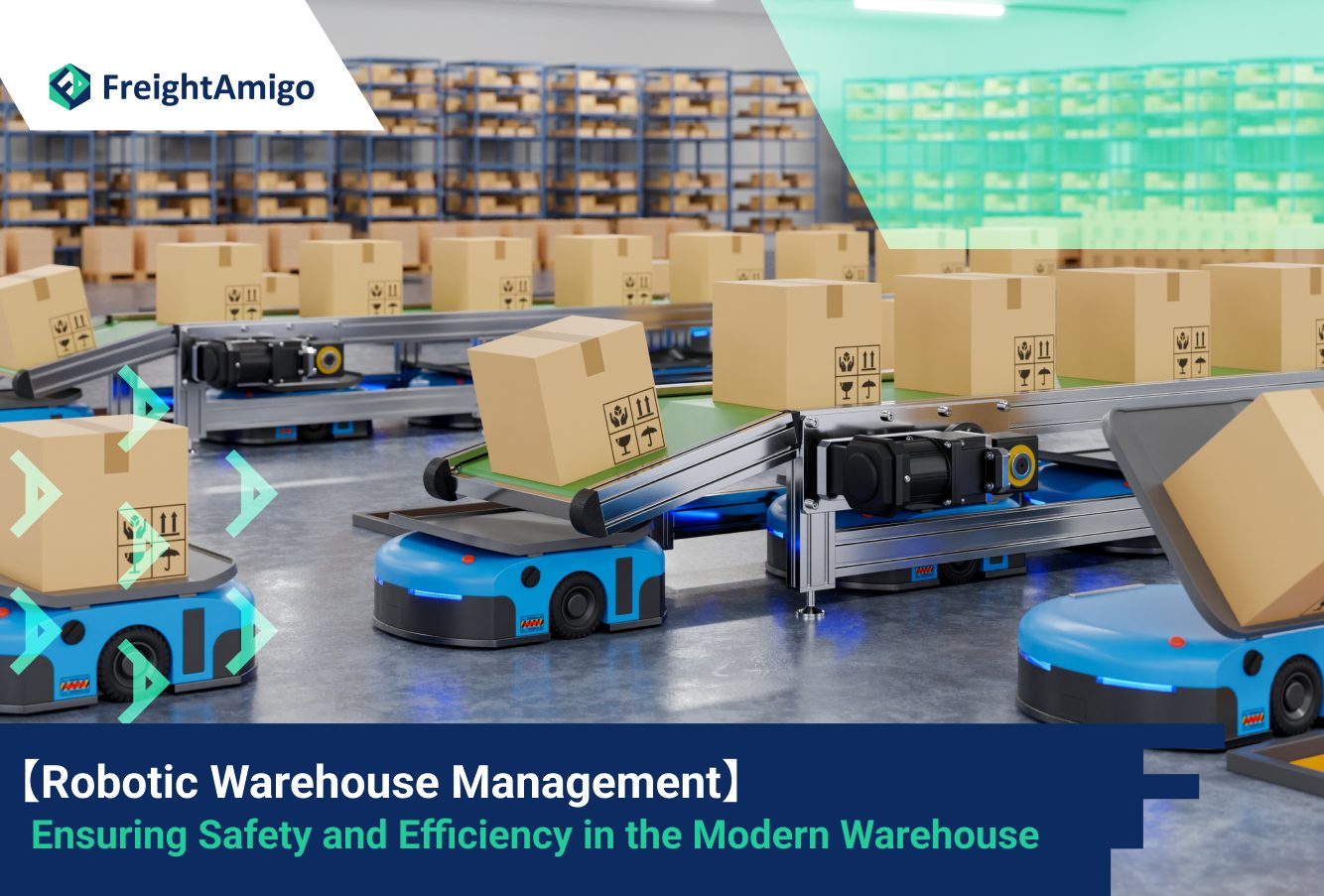Author Name: Tiffany Lee – Marketing Analyst at FreightAmigo
The rise of automation and robotics has revolutionized the way warehouses operate. By implementing robotic warehouse management systems, companies can enhance safety, improve efficiency, and optimize their operations. However, with the integration of robotics, safety considerations become paramount. In this comprehensive guide, we will explore the crucial safety considerations for implementing robotics in the warehouse, the benefits they bring to the workforce, and strategies to ensure a secure and efficient implementation.
Want To Compare The Best Express, Air Freight, Sea Freight, Rail Freight & Trucking Rates So As To Have Better Control On Cost?
Conducting a Comprehensive Risk Assessment
To ensure a secure implementation of robotics in the warehouse, conducting a comprehensive risk assessment is of utmost importance. This process allows companies to identify and evaluate potential hazards and risks associated with the integration of robotics and AI.
Establishing a Diverse Assessment Team
The first step in conducting a risk assessment is to establish a diverse team consisting of warehouse managers, safety officers, operations personnel, and technical experts. This collaborative approach ensures that different perspectives and areas of expertise are considered during the risk assessment process.
Identifying Potential Hazards
Next, the warehouse environment, equipment, and processes need to be carefully examined to identify potential hazards associated with robotics and AI. Factors such as robot movements, interactions with humans, electrical systems, ergonomics, material handling, and environmental conditions should be evaluated.
Assessing Likelihood and Severity
During the risk assessment, it is essential to assess the likelihood and severity of each identified risk. This information will help prioritize and allocate resources effectively. The goal is to eliminate or minimize risks through suitable control measures and mitigation strategies.
Providing Proper Training to Workers
To ensure a secure implementation of robotics and AI in the warehouse, providing proper training to workers is vital. This training should focus on equipping employees with the necessary skills and knowledge to navigate the evolving technological landscape.
Evaluating Training Needs
Begin by evaluating the training needs of the workforce and assessing their existing skill levels. Identify any knowledge gaps that may exist regarding these technologies. Consider the specific tasks employees will perform and the competencies they need to acquire.
Implementing Effective Training Programs
Develop and implement training programs that address the identified needs of the workforce. These programs should cover areas such as robot operation, maintenance, troubleshooting, and emergency procedures. Regular training sessions and refresher courses should be provided to ensure ongoing competence.
Fostering Collaboration Between Humans and Machines
Promote a culture of collaboration between humans and machines in the warehouse. Encourage workers to actively participate in the integration process and provide feedback on potential safety concerns. This collaborative approach creates a harmonious working environment where humans and robots can work together effectively.
Enhancing Workplace Safety Through Automation
Implementing automation in the warehouse can significantly enhance workplace safety by reducing the risk of accidents and injuries. Robotics and AI technologies offer several safety advantages that contribute to a safer working environment.
Reducing Physical Strain
One of the key benefits of robotics in the warehouse is their ability to automate manual repetitive tasks, reducing the physical strain on human workers. Tasks such as heavy lifting, carrying, or moving large items can be automated, minimizing the risk of physical injuries and allowing workers to focus on more skilled and cognitive tasks.
Enhancing Workplace Safety
Robots are designed to follow strict safety protocols, helping to prevent workplace accidents and injuries. Equipped with sensors and advanced algorithms, robots can detect and avoid collisions with human workers, creating a safer environment in the warehouse. Additionally, robots can perform tasks in hazardous areas or handle dangerous materials, reducing the exposure of human workers to potential risks.
Increasing Productivity and Efficiency
Automation in the warehouse not only improves safety but also increases productivity and efficiency. Robots automate material handling tasks, improve inventory management, and streamline order fulfillment processes. This frees up workers’ time, reduces manual tasks, and enhances overall operational effectiveness in the warehouse environment.
Choosing the Right Robotics Solution
When implementing robotics in the warehouse, it is crucial to choose the right robotics solution that aligns with the specific needs and requirements of the business. Consider factors such as scalability, compatibility with existing systems, and ease of integration.
Assessing Warehouse Environment and Processes
Before selecting a robotics solution, thoroughly assess the warehouse environment, equipment, and processes. Identify areas where automation can bring the most significant improvements in safety and efficiency.
Evaluating Potential Solutions
Research and evaluate different robotics solutions available in the market. Consider factors such as the capabilities of the robots, the level of customization, and the support provided by the robotics provider. Look for solutions that align with the specific goals and objectives of the warehouse.
Partnering with Robotics Experts
To ensure a successful implementation, consider partnering with robotics experts who have a proven track record in the field. These experts can provide guidance and support throughout the integration process, ensuring a seamless transition to a robotic warehouse management system.
Future Trends and Innovations in Robotic Warehouse Management
The field of robotic warehouse management is constantly evolving, with new trends and innovations emerging. Staying up to date with these advancements can help warehouses stay competitive and maximize the benefits of automation.
Collaborative Robotics
Collaborative robotics, also known as cobots, are designed to work alongside human workers, enhancing their capabilities and productivity. These robots can perform tasks that require human dexterity and problem-solving skills, while also ensuring safety through advanced sensors and intuitive programming.
Artificial Intelligence and Machine Learning
Artificial intelligence and machine learning technologies are revolutionizing robotic warehouse management. These technologies enable robots to learn and adapt to their environment, making them more efficient and effective in performing tasks. AI-powered robots can analyze data, optimize workflows, and make real-time decisions, leading to improved productivity and safety.
Integration with Internet of Things (IoT)
The integration of robotics with the Internet of Things (IoT) allows for seamless communication and data exchange between robots, machines, and other warehouse systems. This integration enables warehouses to collect and analyze real-time data, optimize operations, and proactively identify potential safety hazards.
Conclusion
Robotic warehouse management systems have the potential to revolutionize the way warehouses operate, enhancing safety, efficiency, and productivity. By conducting comprehensive risk assessments, providing proper training to workers, and implementing automation, warehouses can create a secure and efficient working environment. As technology continues to advance, staying informed about the latest trends and innovations in robotic warehouse management will be crucial for warehouses to remain competitive and maximize the benefits of automation. Embracing the future of robotics in the warehouse will lead to safer, more efficient operations and a more empowered workforce.
There Are Different Options For Cargo Transportation. If You Want To Choose The Most Convenient And Suitable Solution, It Is Best To Have The Full Support Of Logistics Experts! If You Are Planning To Ship Goods Overseas, Please Go To The FreightAmigo Page For Inquiries.
===
Read More:
【Rise of Robotic Warehouses】 How They have Influenced the Supply Chain Industry
【Robotic Process Automation】 Revolutionizing Financial Operations for Logistics Companies
===
If you have any inquiries on logistics/supply chain, feel free to contact FreightAmigo now:
Chat with us online OR
Phone : +852 28121686
WhatsApp: +852 27467829









































